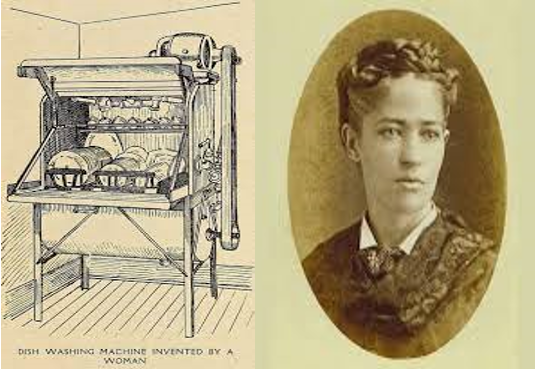Did you know? Female inventor of the dishwasher presented the first model in Illinois!
- Details

Cochran received the first U.S. patent for her commercially successful dishwasher on Dec. 28, 1886. She later unveiled her invention at the 1893 Chicago World’s Fair. She expected the invention to take to homes immediately. However, at first only restaurants and hotels were interested by her idea, and it was not until the 1950s when dishwashers became popular accessories for American homes.
Her invention had dishes fit in compartments in a wheel that turned inside a copper boiler. It was no surprise Cochran was able to come up with a brilliant idea, as she was born into a family of inventors. Her grandfather was awarded the patent for the steamboat. She built her prototype for the machine alongside mechanic George Butters. Eventually, her invention led to the creation of the company that would later be known as KitchenAid. For her invention, Josephine Cochran was inducted into the Inventors Hall of Fame in 2006.
Cochran built her prototype in Shelbyville and unveiled it at the Chicago World’s Fair. She succeeded in her goal of helping the American housewife, even if it took a few decades for the idea to take off in American households. A common household appliance and its inventor can trace their origins back to Illinois.
Notable Birthdays: Distinguished Illinois figures born in December
- Details
 December is winding down, and January and the New Year are fast approaching. However, before you take a break for the holiday season, let’s take a moment to celebrate the month of December and Illinois. Many birthdays of note from those born in Illinois occurred in December. History starts the moment we are born. The famous, historic, or otherwise distinguished figures who can track their birthplaces back to Illinois in December are as follows:
December is winding down, and January and the New Year are fast approaching. However, before you take a break for the holiday season, let’s take a moment to celebrate the month of December and Illinois. Many birthdays of note from those born in Illinois occurred in December. History starts the moment we are born. The famous, historic, or otherwise distinguished figures who can track their birthplaces back to Illinois in December are as follows:
- John Malkovich: American Actor, producer and director best known for his role in the movie Red, born on Dec. 9, 1953 in Christopher
- Seth Myers: Comedian best known for his time on SNL’s Weekend Update, born on Dec. 28, 1973 in Evanston
- Rickey Henderson: American baseball player for the Dodgers and Red Sox, born on Dec. 25, 1958 in Chicago
- Daryl Hannah: Actress, screenwriter, and environmental activist best known for her role as Elle Driver in Kill Bill, born on Dec. 3, 1960 in Chicago
Did you know? Peoria has the Longest Running Santa Parade!
- Details

There is roughly 85 or more contestants in the parade that compete for the best novelty unit, best overall unit, best new entry, best commercial float entry, best non-profit float entry, and best religious float entry – this year’s theme being “Winter Wonderland.” A common tradition that the parade has followed is being right after Thanksgiving to kick off the upcoming winter holiday season with an average of 50,000 parade watchers attending.
The first parade in 1887 originally had boats and derricks sailing down the river as a celebration of the beginning of the new Upper Free bridge construction. However, the year after, the city decided to hold a parade through town, celebrating the completion of the bridge. The following year, Frederick Block of the Schipper and Block Department Store (later renamed Block & Kuhl's) sponsored a parade that followed the same route and featured Santa Claus. The parade was then first televised in 1958.This concept created the department-store sponsored parades that are currently popular at every Thanksgiving and Christmas in America. Talk about iconic! In addition to the parade attractions, there was also fireworks, occasionally a circus performance as well as the adored live reindeer exhibit.
During the first 72 years of the parade, its sponsorship by the Schipper and Block Department Store of Peoria had grown the event to 3,000 parade participants and included a 43-pipe calliope, fireworks and floats constructed by store employees and volunteers. The parade during this time ended with Santa climbing a fire escape ladder and disappearing through a window into the store’s toy department. Downtown Peoria truly is a site to see around the holidays, and having the longest-ran Santa parade makes it the perfect spot to visit to get into the festive spirit.
Celebrating Carol Moseley-Braun: The Glass Ceiling Breaker
- Details
 Senator Carol Moseley-Braun has had numerous firsts in her career. A Chicago native, she was born on August 16, 1947 and has been driven to make big changes since her childhood. Her first interest in politics began after her fight to preserve a habitat for the bobolink, a native Illinois bird, in Chicago’s Jackson Park. From there, she knew she wanted to work more intimately with environmental issues and sustainability.
Senator Carol Moseley-Braun has had numerous firsts in her career. A Chicago native, she was born on August 16, 1947 and has been driven to make big changes since her childhood. Her first interest in politics began after her fight to preserve a habitat for the bobolink, a native Illinois bird, in Chicago’s Jackson Park. From there, she knew she wanted to work more intimately with environmental issues and sustainability.
Moseley-Braun’s first step was receiving her bachelor’s degree in political science from the University of Illinois in 1969. Shortly after, she received her Juris Doctor at the University of Chicago Law School in 1972. After graduation, she went on to be a prosecutor in the office of the U.S. Attorney in Chicago from 1973 to 1977, then served in the Illinois House of Representatives from 1979 to 1989. Her impressive groundbreaking firsts began with her next role: Recorder of Deeds in Cook County – becoming the first Black person to hold an executive position in that county.
Her accomplishments only went higher, as after four years of being Recorder of the Deeds she went on for a successful bid for the U.S. Senate. In 1993, Moseley-Braun became the first Black woman to serve in the U.S. Senate, as well as being the first female Senator from Illinois. In addition, she was also the first woman to serve on the Senate Finance Committee. Her leadership has opened doors for women in public service nationwide. After one term as a U.S. Senator, she then served as the U.S. ambassador to Samoa (2000-2001) and New Zealand (1999-2001).
Over her tenure as a legislator, she authored legislation to provide federal funds to repair dilapidating public schools, extend credit to farmers, aid in cleaning up polluted industrial sites as well as being a forceful advocate for the expansion towards pension benefits for women in the workplace. Senator Moseley-Braun has worked tirelessly over the decades to speak up for historically underserved communities. After many years in public service, she went on to lead Good Food Organics in 2005, which follows her commitment to public responsibility through a business approach of environmental sustainability and financial profitability. Moseley-Braun also became a visiting professor of political science at Northwestern University in 2016. She has been a beacon for thousands of young women who want to make waves in public service and truly is one glass ceiling breaker.



